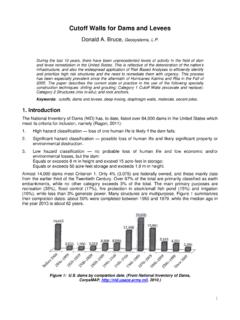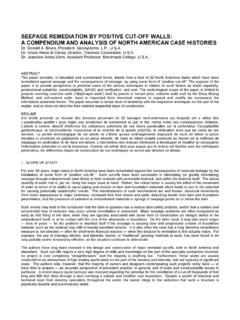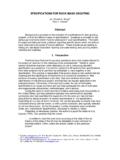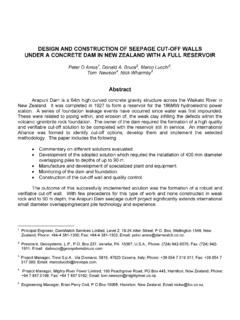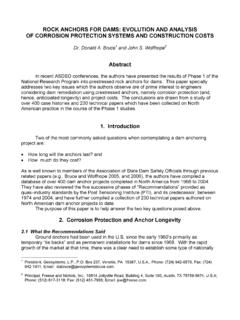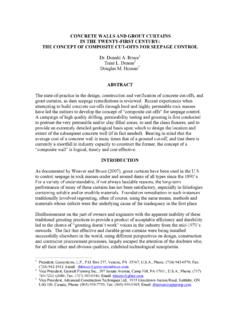Transcription of DESIGN, CONSTRUCTION AND PERFORMANCE OF SEEPAGE …
1 design , CONSTRUCTION AND PERFORMANCE OF SEEPAGE BARRIERS FOR DAMS ON CARBONATE FOUNDATIONS Dr. Donald A. Bruce, Trent L. Dreese, David B. Wilson, ABSTRACT The design , CONSTRUCTION and PERFORMANCE of concrete cut-offs, and grout curtains, as dam SEEPAGE remediations in carbonate foundations is reviewed. Recent experiences when attempting to build concrete cut-offs through hard and highly permeable rock masses have led the authors to develop the concept of composite cut-offs for SEEPAGE control. A campaign of high quality drilling, permeability testing and grouting is first conducted to pretreat the very permeable and/or clay-filled zones, to seal the clean fissures, and to provide an extremely detailed geological basis upon which to design the location and extent of the subsequent concrete wall (if in fact needed). Bearing in mind that the average cost of a concrete wall is many times that of a grouted cut-off, and that there is currently a shortfall in industry capacity to construct the former, the concept of a composite wall is logical, timely and cost effective.
2 INTRODUCTION As documented by Weaver and Bruce (2007), grout curtains have been used in the to control SEEPAGE in rock masses under and around dams of all types since the 1890 s. For a variety of understandable, if not always laudable reasons, the long-term PERFORMANCE of many of these curtains has not been satisfactory, especially in lithologies containing soluble and/or erodible materials. Foundation remediation in such instances traditionally involved regrouting, often of course, using the same means, methods and materials whose defects were the underlying cause of the inadequacy in the first place. Disillusionment on the part of owners and engineers with the apparent inability of these traditional grouting practices to provide a product of acceptable efficiency and durability led to the chorus of grouting doesn t work voices in the industry from the mid-1970 s onwards. The fact that effective and durable grout curtains were being installed successfully elsewhere in the world, using different perspectives on design , CONSTRUCTION and contractor procurement processes, largely escaped the attention of the doubters who, for all their other and obvious qualities, exhibited technological xenophobia.
3 1 President, Geosystems, , Box 237, Venetia, PA 15367, ; Phone: (724) 942-0570; Fax: (724) 942-1911; Email: 2 Vice President, Gannett Fleming Inc., 207 Senate Avenue, Camp Hill, PA 17011, ; Phone: (717) 763-7211 x2686; Fax: (717) 303-0346; Email: 3 Manager, Earth Science and Hydraulics Practice, Gannett Fleming, Inc., Box 67100, Harrisburg, PA 17106; Phone: (717) 763-7211; Fax: (717) 763-1808; Email: Partly as a result of the anti-grouting lobby, equally in response to indisputable geological realities and challenges and building on technical advances in slurry wall techniques, the concept and reality of positive cut-offs became the mantra for major embankment dam foundation rehabilitation in North America from 1975 onwards. Such walls, built through and under existing dams by either the panel wall technique, or secant large diameter piles, comprise some type of concrete, ranging from high strength to plastic.
4 In contrast to grout curtains, where well over 90% of the cut-off is, in fact, the virgin, in situ rock, these positive cut-offs were, in theory, built of 100% pre-engineered material of well-defined properties. Such positive walls are essential to provide long-term cut-off across karstic features which contain residual, potentially erodible material: such material simply cannot be grouted with a degree of uniformity and confidence to assure satisfactory long-term PERFORMANCE . The list of successful projects executed to date in the is extremely impressive (Bruce et al., 2006; Bruce 2007), with many having been installed in carbonate terrains of varying degrees of karstification. To date almost million square feet of concrete cut-off have been installed in 20 projects. From the mid-1980 s albeit in Europe (Lombardi 2003) a new wave of dam grouting concepts began to emerge. Given that most of the leading North American practitioners had close corporate and/or professional and personal links with this insurgency, it is not surprising that their heretofore moribund industry began to change.
5 By the time of the seminal 2003 ASCE grouting conference in New Orleans, the revolution in North American practice for dam foundation grouting had been clearly demonstrated (Wilson and Dreese, 2003; Walz et al., 2003). The concept of a Quantitatively Engineered Grout Curtain was affirmed. Differences in opinion and philosophies with the great European practitioners such as Lombardi, the architect of the GIN Method, were not necessarily resolved: they were debated between equals and the respective opinions fairly acknowledged. It is therefore the case that, in North America, there is now expertise and experience of an unparalleled level in both grout curtains and concrete cut-off walls. This is particularly serendipitous given that the dollar requirement for the application of both technologies in Federal dams alone in the next 5 years is of an order equivalent to the aggregate of the preceding 40 years (Halpin, 2007). This paper presents a review of the current state-of-practice in each of these two technologies.
6 The paper describes how these techniques can be combined in the concept of a composite cut-off which has potentially extraordinary benefits to owners in the financial sense, while still assuring the highest verifiable standards of PERFORMANCE and durability in the field. CUT-OFFS Investigations, design , Specifications and Contractor Procurement Intensive, focused site investigations are essential as the basis for cut-off design and contractor bidding purposes. In particular, these investigations must not only identify rock mass lithology, structure and strength ( rippability ), but also the potential for loss of slurry during panel excavation. This has not always been done, and cost and schedule have suffered accordingly on certain major projects. Special considerations have had to be made when designing cut-offs which must contact existing concrete structures, or which must be installed in very deep-sided valley sections, or which must toe in to especially strong rock.
7 Test Sections have proved to be extremely valuable, especially for the contractor to refine his means, methods and quality control systems. Such programs have also given the dam safety officials and owners the opportunity to gain confidence and understanding in the response of their dams to the invasive surgery that constitutes cut-off wall CONSTRUCTION . Furthermore, such programs have occasionally shown that the foreseen CONSTRUCTION method was practically impossible ( , a hydromill at Beaver Dam, AR) or that significant facilitation works ( , pregrouting of the wall alignment at Mississinewa Dam, IN, Clearwater Dam, MO, and Wolf Creek Dam, KY) were required. Every project has involved a high degree of risk and complexity and has demanded superior levels of collaboration between designer and contractor. This situation has been best satisfied by procuring a contractor on the basis of best value, not low bid. This involves the use of RFP s (Requests for Proposals) with a heavy emphasis on the technical submittal and, in particular, on corporate experience, expertise and resources, and the project-specific Method Statement.
8 These projects are essentially based on PERFORMANCE , as opposed to Prescriptive Specifications . Partnering arrangements (which are post-contract) have proved very useful to both parties when entered into with confidence, enthusiasm, and trust. CONSTRUCTION and QA/QC The specialty contractors have developed a wide and responsive variety of equipment and techniques to assure penetration and wall continuity in a wide variety of ground conditions. More than one technique, , clamshell followed by hydromill, has frequently been used on the same project and especially where bouldery conditions have been encountered. Cut-offs can be safely constructed with high lake levels, provided that the slurry level in the trench can be maintained a minimum of 3 feet higher. In extreme geological conditions, this may demand pretreatment of the embankment ( , Mud Mountain Dam, WA) or the rock mass (Mississinewa Dam, IN) to guard against massive, sudden slurry loss. For less severe geological conditions, contractors have developed a variety of defenses against slurry losses of smaller volume and rate by providing large slurry reserves, using flocculating agents, and fillers in the slurry, or by limiting the open-panel width.
9 Very tight verticality tolerances are necessary to assure continuity especially in deeper cut-offs. Such tolerances have been not only difficult to satisfy, but also difficult to measure accurately (to of wall depth) and verify. The deepest panel walls have been installed at Wells Dam, WA (223 feet, clamshell) and at Mud Mountain Dam, WA (402 feet, hydromill). The hydromill has proved to be the method of choice for large cut-offs in fill, alluvial soils and in rock masses of unconfined compressive strengths less than 10,000 psi (massive) to 20,000 psi (fissile, and therefore, rippable). Secant pile cut-offs are expensive and intricate to build. However, they are the only option in certain conditions ( , heavily karstified, but otherwise hard limestone rock masses) which would otherwise defeat the hydromill. The deepest such wall (albeit a composite pile/panel wall) was the first at Wolf Creek, KY in 1975 which reached a maximum of 280 feet. The most recent pure secant pile wall in carbonate terrain was at Beaver Dam, AR, 1992-1994.
10 A wide range of backfill materials has been used, ranging from low strength plastic concrete, to conventional high strength concrete. The preparation and maintenance of a stable and durable working platform has proved always to be a beneficial investment, and its value should not be underestimated. The highest standards of real time QA/QC and verification are essential to specify and implement. This applies to every phase of the excavation process, and to each of the materials employed. Enhancements have progressively been made in cut-off excavation technology, especially to raise productivity (particularly in difficult conditions), to increase mechanical reliability, and to improve the practicality and accuracy of deviation control and measurement. Potential CONSTRUCTION Issues with Cut-Offs Satisfactory CONSTRUCTION of positive cut-off walls requires experience, skill, and dedication to quality in every aspect of the CONSTRUCTION process including site preparation, excavation, trench or hole cleaning, concrete mixing, and concrete backfilling.
